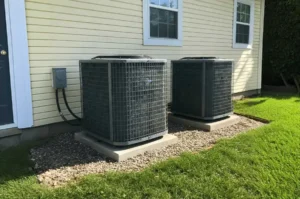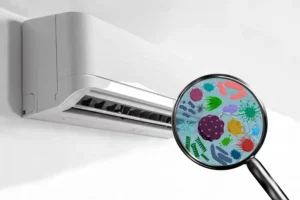Blog Contents
- 1 Understanding Smart Building Technology
- 2 Enhancing Comfort: How Smart Thermostats Optimize HVAC Performance
- 3 Energy Efficiency in the Workplace: The Role of Smart Sensors and Automated Systems
- 4 Integrating IoT Solutions: Creating a Connected and Comfortable Environment
- 5 Choosing the Right Smart Building Solutions: Key Features to Look For
- 6 Future of Workplace Comfort: Trends in Smart Building Technology and Sustainability
Ensuring employee comfort is essential in a hectic business environment. A comfortable workplace boosts morale as well as productivity. Smart building technology is an innovative approach to managing commercial spaces, integrating advanced systems that optimize both comfort and energy efficiency, with a primary focus on heating, ventilation, and air conditioning (HVAC) technologies, such as smart thermostats. Let’s explore how these technologies can transform the workplace.
Understanding Smart Building Technology
Smart building technology refers to a suite of automated systems designed to enhance the operational efficiency of commercial properties. These technologies can control HVAC, lighting, security, and even energy consumption. The benefits of implementing smart building technology in commercial spaces are numerous:
- Increased Comfort: Automated systems can adjust to individual preferences, ensuring a pleasant environment for all.
- Energy Savings: Smart technologies optimize energy use, reducing waste and lowering utility bills.
- Data-Driven Decisions: Analytics provide insights into usage patterns, allowing for informed improvements and adjustments.
- Sustainability: By optimizing resource use, smart buildings contribute to environmental sustainability.
With these benefits in mind, let’s dig deeper into how smart technologies can specifically improve comfort in the workplace.
Enhancing Comfort: How Smart Thermostats Optimize HVAC Performance
One of the key components of smart building technology is the smart thermostat. Unlike traditional thermostats, smart thermostats learn your schedule and preferences, adjusting the temperature accordingly.
Here’s how:
- Personalization: Smart thermostats allow individual employees to set their preferred temperatures. This means that whether someone prefers it toasty warm or refreshingly cool, their needs can be met without affecting the overall building temperature.
- Remote Control: Employees can adjust their thermostat settings via smartphone apps, allowing for changes before they arrive at the office or during the day if they feel too hot or cold.
- Learning Algorithms: These thermostats learn patterns over time, optimizing energy use by adjusting settings based on occupancy and historical data. This not only keeps employees comfortable, but also contributes to energy savings.
- Integration with HVAC Systems: Smart thermostats can communicate with HVAC systems to ensure they operate efficiently, reducing wear and tear and extending the life of the equipment.
Energy Efficiency in the Workplace: The Role of Smart Sensors and Automated Systems
Smart building technology doesn’t stop at thermostats. A comprehensive approach involves smart sensors and automated systems that work together to optimize energy efficiency. Here’s how they contribute:
- Occupancy Sensors: These sensors detect when rooms are occupied and adjust lighting and HVAC accordingly. For example, if a conference room is empty, the system can automatically turn off the lights and adjust the temperature to save energy.
- Light Sensors: Smart sensors can also monitor natural light levels, adjusting artificial lighting to ensure optimal illumination while minimizing energy use. This not only saves electricity but also creates a more pleasant working environment.
- Automated Blinds: Similar to HVAC and lighting, automated blinds can adjust based on the position of the sun, helping to regulate indoor temperatures and reduce glare on screens.
- Data Analytics: Smart systems collect data on energy usage and comfort levels, allowing facility managers to make data-driven decisions about how to improve efficiency and comfort in real time.
Integrating IoT Solutions: Creating a Connected and Comfortable Environment
The Internet of Things (IoT) is at the heart of smart building technology, creating a connected environment where devices communicate effortlessly. Here’s how IoT boosts workplace comfort:
- Centralized Control Systems: IoT-enabled smart building management systems allow facility managers to control HVAC, lighting, and security from a single dashboard. This centralization simplifies management and improves responsiveness.
- Predictive Maintenance: IoT devices can monitor HVAC system performance and predict maintenance needs before issues arise. This proactive approach helps avoid uncomfortable situations caused by system failures.
- Improved Employee Experience: With a connected environment, employees can enjoy a more personalized experience. For example, they can adjust lighting and temperature settings via their smartphones, creating a workspace that suits their preferences.
- Remote Monitoring: Facility managers can monitor systems remotely, allowing them to respond quickly to issues, ensuring comfort and efficiency without being physically present in the building.
Choosing the Right Smart Building Solutions: Key Features to Look For
When selecting smart building technology, it’s essential to consider various features to ensure you’re making the right investment. Here are some key features to look for:
- Compatibility: Ensure the smart technology can integrate with your existing HVAC and building management systems.
- User-Friendly Interface: Look for solutions with intuitive interfaces that make it easy for both employees and facility managers to control settings.
- Robust Data Analytics: Choose systems that offer comprehensive analytics to help you understand usage patterns, enabling informed decision-making.
- Scalability: As your business grows, your smart building technology should be able to scale with you. Look for solutions that can adapt to your changing needs.
- Strong Customer Support: Opt for vendors that offer reliable customer support and training to help you maximize the benefits of your investment.
Future of Workplace Comfort: Trends in Smart Building Technology and Sustainability
The world of smart building technology is on the rise. Here are a few trends shaping the future of workplace comfort:
- Sustainability Initiatives: With increasing awareness of environmental issues, more businesses are adopting smart technologies that enhance energy efficiency and reduce carbon footprints.
- Employee-Centric Design: Future smart buildings will focus even more on employee comfort and well-being, with customizable environments that cater to individual preferences.
- AI Integration: AI will play a more prominent role in smart building management, enhancing predictive capabilities and automating complex tasks.
- Health and Safety Monitoring: In a post-pandemic world, smart building technologies are increasingly incorporating features that monitor air quality and ensure a safe working environment.
Improving workplace comfort with smart building technology goes beyond improving the employee experience. It also optimizes energy efficiency and supports a sustainable future.
By embracing innovations such as smart thermostats, sensors, and IoT solutions, commercial spaces can create environments that are both comfortable and efficient.
If you’re ready to improve your workplace comfort with smart technology, consider investing in smart thermostats from B&H Heating & Air. We have a range of options that can help you create the perfect working environment while saving on energy costs. Contact us today!







